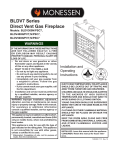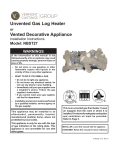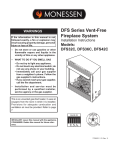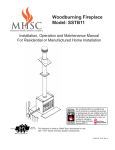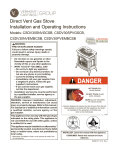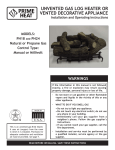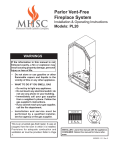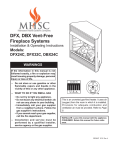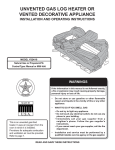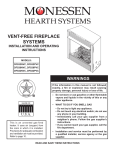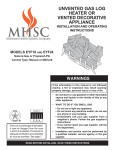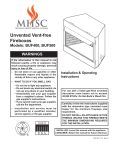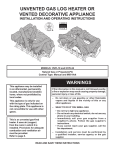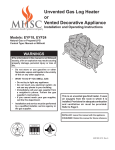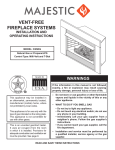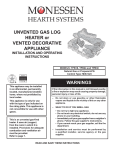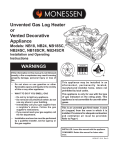Download Manual - Vermont Castings Group
Transcript
VFF Vent Free Fireplace System Installation & Operating Instructions Models: VFF32LI, VFF36LI, VFF32LV, VFF36LV, VFF32CI, VFF36CI, VFF32CV, VFF36CV WARNING: If the information in this manual is not followed exactly, a fire or explosion may result causing property damage, personal injury or loss of life. • • • Do not store or use gasoline or other flammable vapors and liquids in the vicinity of this or any other appliance. WHAT TO DO IF YOU SMELL GAS –Do not try to light any appliance. –Do not touch any electrical switch; do not use any phone in your building. –Leave the buildling immediately. –Immediately call your gas supplier from a neighbor's phone. Follow the gas supplier's instructions. –If you cannot reach your gas supplier, call the fire department. Installation and service must be performed by a qualified installer, service agency or the gas supplier. This is an unvented gas-fired heater. It uses air (oxygen) from the room in which it is installed. Provisions for adequate combustion and ventilation air must be provided. Refer to Page 8. INSTALLER: Leave this manual with the appliance. CONSUMER: Retain this manual for future reference. 20308184 0901 Rev. 1 VFF Vent Free Fireplace System CONTENTS Thank you and congratulations on your purchase of a Vermont Castings Group Fireplace. PLEASE READ THE INSTALLATION AND OPERATION INSTRUCTIONS BEFORE USING THE APPLIANCE. IMPORTANT: Read all instructions and warnings carefully before starting installation. Failure to follow these instructions may result in a possible fire hazard and will void the warranty. Important Safety Information...................................... 3 Codes....................................................................... 4 Product Features.......................................................... 5 Operation................................................................. 5 Gas Pressures......................................................... 5 Gas Specifications and Orifice Sizes....................... 5 Ignition Controls....................................................... 5 Pilot.......................................................................... 5 Thermal Generator................................................... 5 Cold Climate Option................................................. 6 Fireplace and Framing Dimensions............................ 7 Pre-installation Information......................................... 8 Getting Started......................................................... 8 What You Will Need for Installation.......................... 8 Adequate Combusion and Ventilation...................... 8 Fireplace Installation.................................................... 9 Fireplace Location.................................................... 9 Clearances............................................................. 10 Framing and Anchoring ......................................... 10 Securing Heater to Floor or Hearth........................ 11 Gas Line & Pressure.................................................. 12 Connecting the Gas Line....................................... 12 Checking Gas Pressure: Millivolt Control............... 12 Check Gas Pressure — IPI.................................... 13 Final Installation......................................................... 13 Remove Screen..................................................... 13 Install Canopy........................................................ 13 Electrical Wiring — Millivolt...................................... 14 Connect Optional Wall Switch or Thermostat........ 14 Connect Remote Receiver..................................... 15 Check System Operation....................................... 16 Operating Instructions — Millivolt............................ 16 For Your Safety Read Before Lighting................... 16 Lighting Pilot for the First Time.............................. 16 Lighting Pilot.......................................................... 17 Lighting Burner....................................................... 18 To Turn Off Gas...................................................... 18 Electrical Installation — IPI....................................... 19 Electrical Wiring..................................................... 19 Junction Box Wiring............................................... 19 Wall Switch Installation.......................................... 20 IPI System Wiring Diagram.................................... 20 2 Operating Instructions — IPI..................................... 21 EcoLogic Control.................................................... 21 For Your Safety Read Before Lighting................... 22 What to Do If You Smell Gas................................. 22 Operating Instructions............................................ 22 To Turn Off Gas to Appliance................................. 22 Electrical Wiring — Fan............................................. 19 Log and Media Placement......................................... 23 Cast Iron Grate Installation.................................... 23 Rock Wool Placement............................................ 23 Log Placement - BO24(F-R).................................. 24 Log Placement - HO24(F-R).................................. 25 Log Placement - KW24-R...................................... 26 Log Placement - 24ST-R/SC24-R.......................... 28 Glass Only Placement........................................... 29 Flame Appearance...................................................... 30 Pilot and Burner Flame Appearance...................... 30 Check the Pilot Flame............................................ 30 Checking Burner Flame......................................... 30 Operating Instructions............................................ 30 Operating Instructions............................................... 31 For Your Safety Read Before Lighting................... 31 Millivolt/Thermostat Control Lighting Instructions.. 32 To Turn Off Gas to Heater...................................... 32 Match Lighting Instructions.................................... 33 Blower Operation................................................... 33 Cleaning and Servicing.............................................. 34 Annual Cleaning and Inspection............................ 34 Periodic Cleaning .................................................. 34 Optional Accessories................................................. 35 Installing Optional Firebrick Panels........................ 35 Installing Optional Porcelain Panels...................... 36 Installing Optional Black Magic Panels.................. 36 Outside Combustion Air............................................ 37 Troubleshooting......................................................... 40 Replacement Parts..................................................... 43 VFF Firebox Parts ................................................. 43 VFF32/36 Millivolt Burner Parts ............................ 44 VFF32/36 IPI Burner Parts .................................... 45 Log Parts................................................................ 46 Warranty...................................................................... 51 20308184 IMPORTANT SAFETY INFORMATION VFF Vent Free Fireplace System INSTALLER OWNER Please leave these instructions with the appliance. Please retain these instructions for future reference. WARNING: • Any change to this heater or its controls can be dangerous. • Improper installation or use of the heater can cause serious injury or death from fire, burns, explosion or carbon monoxide poisoning. • Do not allow fans to blow directly into the fireplace. Avoid any drafts that alter burner flame patterns. • Do not use a blower insert, heat exchanger insert or other accessory, not approved for use with this heater where applicable. 1. Due to high temperatures, the appliance should be located out of traffic and away from furniture and draperies. 2. Children and adults should be alerted to the hazard of high surface temperature and should stay away to avoid burns or clothing ignition. 3. Young children should be carefully supervised when they are in the same room with the appliance. 4. Do not place clothing or other flammable material on or near the appliance. 5. Any safety screen or guard removed for servicing an appliance, must be replaced prior to operating the heater. 6. Installation and repair should be done by a qualified service person. 7. To prevent malfunction and/or sooting, an unvented gas heater should be cleaned before use and at least annually by a professional service person. More frequent cleaning may be required due to excessive lint from carpeting, bedding materials, etc. It is imperative that control compartments, burners and circulating air passageways be kept clean. 8. CARBON MONOXIDE POISONING: Early signs of carbon monoxide poisoning are similar to the flu with headaches, dizziness and/or nausea. If you have these signs, obtain fresh air immediately. Have the heater serviced as it may not be operating properly. 9. The installation must conform with local codes or, in the absence of local codes, with the National Fuel Gas Code, ANSI Z223.l/NFPA54. 10. This unit complies with the latest edition of ANSI Z21.11.2–2013, Unvented Heaters. 11. Do not install the heaters in a bathroom or bedroom. 12. Correct installation of the refractory cement or ceramic fiber logs, proper location of the heater, and annual cleaning are necessary to avoid potential problems with sooting. Sooting, resulting from improper installation or operation, can settle on surfaces outside the fireplace. See log placement instructions for proper installation. 20308184 13. Avoid any drafts that alter burner flame patterns. Do not allow fans to blow directly into fireplace. Do not place a blower inside burn area of firebox. Ceiling fans may create drafts that alter burner flame patterns. Sooting and improper burning will occur. 14. CAUTION: Candles, incense, oil lamps, etc. produce combustion byproducts including soot. Vent-free appliances will not filter or clean soot produced by these types of products. In addition, the smoke and/ or aromatics (scents) may be reburned in the vent-free appliance which can produce odors. It is recommended to minimize the use of candles, incense, etc. while the vent-free appliance is in operation. 15. This is an unvented gas-fired heater. It uses air (oxygen) from the room in which it is installed. Provisions for adequate combustion and ventilation air must be provided. Refer to page 8. 16. This heater shall not be installed in a room or space unless the required volume of indoor combustion air is provided by the method described in the National Fuel Gas Code, ANSI Z223.1/NFPA 54, the International Fuel Gas Code or applicable local codes. 17. Keep room area clear and free from combustible materials, gasoline and other flammable vapors and liquids. 18. Unvented gas heaters are a supplemental zone heater. They are not intended to be the primary heating appliance. 19. Unvented gas heaters emit moisture into the living area. In most homes of average construction, this does not pose a problem. In houses of extremely tight construction, additional mechanical ventilation is recommended. 20. During manufacturing, fabricating and shipping, various components of this appliance are treated with certain oils, films or bonding agents. These chemicals are not harmful but may produce annoying smoke and smells as they are burned off during the initial operation of the appliance; possibly causing headaches or eye or lung irritation. This is a normal and temporary occurrence. 3 IMPORTANT SAFETY INFORMATION VFF Vent Free Fireplace System The initial break-in operation should last six hours with the burner at the highest setting. Provide maximum ventilation by opening windows or doors to allow odors to dissipate. Any odors remaining after this initial break-in period will be slight and will disappear with continued use. 21. Input ratings are shown in BTU per hour and are for elevations up to 2,000 feet. For elevations above 2,000 feet, input ratings should be reduced 4 percent for each 1,000 feet above sea level. Refer to the National Fuel Gas Code. 22. The appliance must be isolated from the gas supply piping system by closing its equipment shutoff valve during any pressure testing of the gas supply piping system at test pressures equal to or less than 1/2 psig (3.5 kPa). 23. Do not use this room heater if any part has been under water. Immediately call a qualified service technician to inspect the room heater and to replace any part of the control system and any gas control which has been under water. 24. Never burn solid fuels in a fireplace where a unvented room heater is installed. 25. Always have a fireplace screen in place when the appliance is in operation and, unless other provisions for combustion air are provided, the screen must have an opening(s) for induction of combustion air. THIS APPLIANCE MAY BE INSTALLED IN AN AFTER-MARKET, PERMANENTLY LOCATED, MANUFACTURED (MOBILE) HOME, WHERE NOT PROHIBITED BY LOCAL CODES. THIS APPLIANCE IS ONLY FOR USE WITH THE TYPE OF GAS INDICATED ON THE RATING PLATE. THIS APPLIANCE IS NOT CONVERTIBLE FOR USE WITH OTHER GASES. WARNING: Never connect unit to private (non-utility) gas wells. This gas is commonly known as wellhead Nous recommandons quegas. nos appareils de chauffage au gaz soient installés et entretenus par des professionnels qui ont été accrédités aux È.U. par le National Fireplace Institute ® (NFI) comme étant des spécialistes du NFI en matièred’appareils de chauffage au gaz. CODES Adhere to all local codes or, in their absence, the latest edition of THE NATIONAL FUEL GAS CODE ANSI Z223.1 or NFPA54 which can be obtained from: American National Standards Institute, Inc. 1430 Broadway New York, NY 10018 or National Fire Protection Association, Inc. Batterymarch Park Quincy, MA 02269 4 20308184 PRODUCT FEATURES VFF Vent Free Fireplace System GAS SPECIFICATIONS AND ORIFICE SIZES MODEL Fireplace Screen On/Off Switch Piezo Ignition Control Knobs Figure 1 VFF Shown with Control Access Door Open OPERATION This unvented gas heater requires no outside venting and burns cleanly with excellent heating efficiency. As a zero-clearance appliance, it can be installed against (or recessed into) any wall that is accessible to a gas line. MAX BTU MIN ORIFICE BTU SIZE VFF32CNV NAT MILLIVOLT 37,000 25,000 3.00mm VFF32CPV LP MILLIVOLT 36,000 28,000 #49 VFF32CNI NAT IPI 37,000 25,000 3.00mm VFF32CPI LP IPI 36,000 28,000 #49 VFF32LNV NAT MILLIVOLT 37,000 25,000 3.00mm VFF32LPV LP MILLIVOLT 36,000 28,000 #49 VFF32LNI NAT IPI 37,000 25,000 3.00mm VFF32LPI LP IPI 36,000 28,000 #49 VFF36CNV NAT MILLIVOLT 37,000 25,000 3.00mm VFF36CPV LP MILLIVOLT 36,000 28,000 #49 VFF36CNI NAT IPI 37,000 25,000 3.00mm VFF36CPI LP IPI 36,000 28,000 #49 VFF36LNV NAT MILLIVOLT 37,000 25,000 3.00mm VFF36LPV LP MILLIVOLT 36,000 28,000 #49 VFF36LNI NAT IPI 37,000 25,000 3.00mm VFF36LPI LP IPI 36,000 28,000 #49 NOTE: For LP models an external regulator is required to reduce supply pressure to a maximum of 13" w.c. IGNITION CONTROLS (MILLIVOLT ONLY) GAS PRESSURES FUEL CONTROL Control Fuel Millivolt and IPI Regulator Pressure Nat. 3.5" w.c. Pilot Regulator Nat. 3.5" w.c. Max. Inlet Pressure Nat. 10.5" w.c. Min. Inlet Pressure Nat. 5.0" w.c. Regulator Pressure LP 10.0" w.c. Max. Inlet Pressure LP 13.0" w.c. Min. Inlet Pressure LP 11.0" w.c. Piezo ignitor allows ignition of the pilot without the use of matches or batteries. Millivolt control has four (4) positions: OFF - All gas to the gas logs is shut off at the valve. IGN - Valve position to light/maintain a standing pilot. ON - Valve position to turn ON/OFF log set with remote switch/thermostat. LOW/HI - Variable position to control flame height (heat output). THERMAL GENERATOR (MILLIVOLT ONLY) The millivolt gas log pilot is fitted with a millivolt generator to provide power for remote activation. PILOT The gas log heater is fitted with a specially designed safety pilot light (ODS assembly) which senses the amount of oxygen available in the room and shuts the gas log heater off if the oxygen level begins to drop below a satisfactory level. The pilot can only be re-lit when adequate fresh air is available. 20308184 5 VFF Vent Free Fireplace System COLD CLIMATE OPTION (IPI Models Only) NOTE: If you live in a cold climate, seal all cracks around your appliance and wherever cold air could enter the room, with noncombustible material. It is especially important to insulate the outside chase cavity between the studs and under the floor on which the appliance rests, if the floor is above ground level. Your fireplace is equipped with an intermittent pilot ignition (IPI) control. An IPI control with a standing pilot option provides the dual benefit of an economical and environmentally responsible product and one which lights easily even in the coldest climates. When in intermittent pilot mode (as it comes from the factory), your pilot remains unlit until needed, saving you fuel. Standing pilot mode, by comparison, is characterized by a continuously burning pilot. The benefit of a pilot which lights only when needed is fuel savings. However, with no pilot burning in your fireplace, units operating in colder climates may experience delayed start up or lock out. Because colder air is heavier than milder air and there is no pilot burning to maintain a warm stable temperature in your firebox, establishing a draft to aid ignition becomes difficult. This is perfectly normal but can be somewhat frustrating. COLD CLIMATE OPTION To remedy this issue, your fireplace has been designed with a cold climate pilot option, which, when active, maintains a warmer temperature inside your firebox to make ignition faster and more efficient. Operating your appliance in cold climate (aka standing) pilot mode will prohibit the need for multiple ignition attempts and will prevent the system from delaying start up or locking out. To activate the cold climate option, simply move the cold climate toggle switch located on the right side of the black control center to the “On” (left) position. (Figure 2) You can operate your appliance in this mode regardless of whether you are using a remote control, wall switch or thermostat. Cold Climate Switch Master Switch Figure 2 Cold Climate Option 6 20308184 FIREPLACE AND FRAMING DIMENSIONS VFF Vent Free Fireplace System D K Q Min. Rough Opening Depth P H N 1/2” or 5/8” Q M - Min. Rough Opening Width Min. Rough Opening Height O J G L B E C I F A Figure 3 Fireplace and Framing Dimensions Ref. A B C VFF32 VFF36 37" (940 mm) 334051 32" (813 mm) VFS DBX dims 341⁄2" (876 mm) 41" (1041 mm) 36" (914 mm) 341⁄2" (876 mm) D 29" (737 mm) 32" (813 mm) E 3 21 ⁄4" (553 mm) 3 21 ⁄4" (553 mm) F 6" (152 mm) 6" (152 mm) G 5 ⁄16" (138 mm) 5 ⁄16" (138 mm) H 5 18 ⁄8" (473 mm) 5 20 ⁄8" (524 mm) I 21⁄2" (64 mm) 21⁄2" (64 mm) J 16" (406 mm) 18" (457 mm) K 23 ⁄8" (594 mm) 27 ⁄8" (695 mm) 7 3 7 3 Framing Dimensions 20308184 L 35" (889 mm) 35" (889 mm) M 371⁄4" (946 mm) 411⁄4" (1048 mm) N 151⁄2" (394 mm) 171⁄2" (445 mm) O 3 61 ⁄4" (1568 mm) 7 68 ⁄8" (1749 mm) P 1 33 ⁄2" (784 mm) 1 37 ⁄8" (943 mm) Q 43 ⁄4" (1111 mm) 48 ⁄4" (1238 mm) 3 3 7 VFF Vent Free Fireplace System WARNING: • Gloves are recommended when handling refractory cement or ceramic fiber logs to prevent skin irritation from loose fibers. Logs are fragile — handle with care. GETTING STARTED Make sure you have received all parts. Check your packing list to verify that all listed parts have been received. You should have the following: • Unvented gas heater • Installation/operating instruction • Canopy and three (3) screws • Glass media (Contemporary model only) •Refractory cemet or ceramic fiber logs sold separately Carefully inspect the contents for shipping damage. If any parts are missing or damaged, immediately inform the dealer from whom you purchased the appliance. Do not attempt to install any part of the appliance unless you have all parts in good condition. WHAT YOU WILL NEED FOR INSTALLATION: You must have the following items available before proceeding with installation: • External regulator (for propane/LPG only) • Manual shutoff valve • Piping which complies with local codes • Sediment trap • Phillips head screwdriver • Tee joint • Pipe sealant approved for use with propane/LPG • Pipe wrench (resistant to sulfur compounds) When planning the installation for the fireplace it is necessary to determine where the unit is to be installed and whether optional accessories are desired. Gas supply piping should also be planned. The following steps represent the normal sequence of installation. Each installation is unique, however, and might require a different sequence. 1. Position fireplace in desired location. Refer to the Location of Fireplace and Clearances and Height Requirements, and Firebox Framing sections found in this manual. NOTE: Be sure all packing material has been removed from underside the unit. 8 PRE-INSTALLATION INFORMATION WARNING—Do not install the heater: • Where curtains, furniture, clothing, or other flammable objects are less than 42" from the front of the heater. • In high traffic areas. • In windy or drafty areas. 2. Install canopy and logs per instructions found in this manual. The canopy MUST be installed for safe operation of the unit. 3. Field wire main power supply to units with fan kit. Refer to the Electrical Section found in this manual. (Electrical connections should only be performed by an experienced, licensed certified tradesman). 4. Install optional ON/OFF kit on units with millivolt control. Refer to the installation instructions included with the kit and also refer to the Electrical Wiring section found in this manual. 5. Plumb gas line. Refer to the Connecting the Gas section found in this manual. (Gas connections should only be performed by an experienced, licensed/certified tradesman). 6. Complete finish wall material and/or surround. ADEQUATE COMBUSTION AND VENTILATION AIR This heater shall not be installed in a confined space or unusually tight construction unless provisions are provided for adequate combustion and ventilation air. The National Fuel Gas Code, (ANSI Z223.1/NFPA54), defines a confined space as a space whose volume is less than 50 cubic feet per 1,000 BTU per hour (4.8m3 per kw) of the aggregate input rating of all appliances installed in that pace, and an unconfined space as a space whose volume is not less than 50 cubic feet per 1,000 BTU per hour (4.8 m3 per kw) of the aggregate input rating of all appliances installed in that space. Rooms communicating directly with the space in which the appliances are installed, through openings not furnished with doors, are considered a part of a confined space. WARNING: If the area in which the heater is operated does not meet the required volume for indoor combustion air, combustion and ventilation air shall be provided by one of the methods described in the National Fuel Gas Code, ANSI Z223.1/NFPA 54, the International Fuel Gas Code or applicable local codes. 20308184 FIREPLACE INSTALLATION VFF Vent Free Fireplace System Unusually tight construction is defined as construction where: a. walls and ceilings exposed to the outside atmosphere have a continuous water vapor retarder with a rating of 1 perm (6 x 1011 kg per pa/sec-m2) or less with openings gasketed or sealed, and b. weather stripping has been added on openable windows and doors, and c. caulking or sealants are applied to areas such as joints around window and door frames, between sole plates and floors, between wall-ceiling joints, between wall panels, at penetrations for plumbing, electrical and gas lines and other openings. The following formula can be used to determine the maximum heater rating per the definition of unconfined space: FIREPLACE LOCATION Carefully select the best location for installation of your unvented fireplace. The following factors should be taken into consideration. • Clearance to side wall, ceiling, woodwork and • • • BTU/Hr = (L1 + L2) Ft x (W) Ft x (H) Ft 50 • Consider two connecting rooms with an open area between, with the following dimensions: L1 = 151/2 Ft., L2 = 12 Ft., W = 12 Ft., H = 8 Ft. • BTU/Hr = (151/2 + 12) x (12) x (8) 50 • If there were a door between the two rooms the calculation would be based only on the room with the heater. BTU/Hr = (151/2) x (12) x (8) 50 Counter • window or other combustibles. Refer to “Clearances” section. Minimum clearances to combustibles must be maintained. Location must not be affected by drafts caused by kitchen exhaust fans, ceiling fans, return air registers for forced air furnaces / air conditioners, windows or doors. Installation must provide adequate ventilation and combustion air. DO NOT INSTALL THESE MODELS IN A BEDROOM OR BATHROOM. Location should be out of high traffic areas and away from furniture and draperies due to heat from firebox. Never obstruct the front opening of the unvented fireplace or restrict the flow of combustion and ventilation air. Minimize modifications to existing construction. Refer to Figure 5 below for location suggestions. Do not install in the vicinity where gasoline or other flammable liquids may be stored. The unvented firebox must be kept clear and free from the combustible materials. Fireplace H W Figure 4 Combustion Air Calculation Figure 5 Possible Fireplace FP2440 Locations fireplace locations 20308184 9 FIREPLACE INSTALLATION VFF Vent Free Fireplace System CLEARANCES Ensure that minimum clearances shown in Figures 6 and 7 are maintained. Left and right clearances are determined when facing the front of the firebox. Follow these instructions carefully to ensure safe installation. Failure to follow these requirements may create a fire hazard. 12” Combustible material can contact top of fireplace 10” 23” 8” 21” 6” 2¹⁄₂” Sidewall Clearances — The clearance from the inside of the appliance to any combustible adjacent wall should not be less than 9" for the VFF32 and VFF36. Figure 6 19” 16” 12” Ceiling Clearance — The ceiling must be at least 42" from the top of the firebox opening. Figure 6 Non-combustible material Back Wall Clearance — The appliance may be placed against a combustible back wall. Floor Clearance — The fireplace may be installed directly on a combustible floor or a raised platform of an appropriate height. Do not place fireplace on carpeting, vinyl, tile or other soft floor coverings. It may, however, be placed on flat wood, plywood, particle board or other hard surfaces. Be sure fireplace rests on a solid continuous floor or platform with appropriate framing for support and so that no cold air can enter from under the firebox. Figure 7aMantel Clearances FP2442 mantel clearances Finish Wall Combustible Material Area Mantel clearances — The canopy supplied with the unit must be installed. If a combustible mantel is installed. It must meet the clearance requirements detailed in Figure 6. NOTE: The Vermont Castings Group Barrington cabinet model series BWC400 and BWC500 are specially designed to comply with all mantel temperature requirements. Any custom-built mantel must comply with all clearance requirements shown in this instruction manual. 1” 2¹⁄₂” 3” 1¹⁄₂” 3¹⁄₂” 4¹⁄₂” 6” 5” 6” 7¹⁄₂” 45° 7¹⁄₂” 9” 42" Minimum 9" Minimum 9" Minimum Figure 7bMantel Leg Clearances FP2692 mantel leg clearance WARNING: The dimensions shown in Figures 6, 7a, and 7b are minimum clearances to maintain in installing this heater. Left and right clearances are determined when facing the front of the heater. Follow these instructions carefully to ensure safe installation. Failure to follow instructions exactly can create a fire hazard. Figure 6 Sidewall and Ceiling Clearances FP2441 sidewall clg clear 10 20308184 FIREPLACE INSTALLATION FRAMING AND ANCHORING If unit is to be “built in”, fireplace framing can be built before or after the appliance is set in place. BE SURE THAT ALL PACKING MATERIAL HAS BEEN REMOVED FROM THE UNDERSIDE OF THE UNIT PRIOR TO SETTING THE FIREBOX IN PLACE. Construct fireplace framing following Fireplace and Framing Dimensions. The framing headers may rest directly on top of the firebox. The fireplace may be installed directly on a combustible floor or a raised platform of an appropriate height. Do not place fireplace on carpeting, vinyl, tile or other soft floor coverings. It may, however, be placed on flat wood, plywood, particle board or other hard surfaces. Be sure fireplace rests on a solid continuous floor or platform with appropriate framing for support and so that no cold air can enter from under the firebox. VFF Vent Free Fireplace System SECURING HEATER TO FLOOR OR HEARTH NOTE: Clearance requirements as detailed in the Clearances section on of this manual, must be met before securing the heater in place. To prevent movement, the heater must be secured to the floor or hearth. 1. Open the control access door and remove the screen. 2. Secure the firebox with two anchoring screws (3⁄16" x 11⁄4" length) supplied with the fireplace system. Figure 9 NOTE: If the unit is mounted on carpeting, tile or combustible material without the hearth, a metal or wooden base covering the entire width and depth of the base must be installed. WARNING: The fireplace must be installed giving full consideration to the clearance and height requirements identified in this manual. Anchor fireplace to the side framing members using nailing flanges. 1. Bend out the nailing flanges located on each side of the firebox. 2. Slide the firebox into prepared framing or position firebox in its final position and frame later. 3. Level the firebox by checking the top edge of the firebox. Shim if necessary. 4. Anchor firebox to the side framing members using 8d nails or other suitable fasteners. Figure 8 5. The canopy must be installed for safe operation of the heater. Refer to canopy installation details. Anchor Screws 3 ⁄16" x 11⁄4" Nail Sides Through Nailing Flanges Figure 9 Secure Fireplace to Floor or Hearth Figure 8 Nailing Flanges 20308184 FP2509 nailing flanges 11 GAS LINE & PRESSURE VFF Vent Free Fireplace System CONNECTING THE GAS LINE WARNING: Connecting directly to an unregulated propane/LPG tank can cause an explosion NOTICE: A qualified gas appliance installer must connect the heater to the gas supply. Consult all local codes. WARNING: Use new black iron or steel pipe. Internally tinned copper or copper tubing can be used per National Fuel Code, section 2.6.3, providing gas meets hydrogen sulfide limits, and where permitted by local codes. Gas piping system must be sized to provide minimum inlet pressure (Listed on Data Plate) at the maximum flow rate (BTU/hr). Undue pressure loss will occur if the pipe is too small. A manual shutoff valve must be installed upstream of the appliance. Union tee and plugged 1/8" NPT pressure tapping point should be installed upstream of the appliance. Figure 10 Pipe Coupling Pipe Locations Pressure Tapping Point Installation Gas Supply Inlet Manual Shutoff Valve Figure 10 Gas Connection IMPORTANT: Loosen the pipe adapter on the flex tube 3” Min. before installing to the system piping. Always use an external regulator for all propane/LPG heaters only, to reduce the supply tank pressure to a maximum of 13" w.c. This is in addition to the internal regulator in the heater valve. To reach factory installed flex line, go through access door on right or left side of firebox. FP2447 gas connection WARNING: CHECK GAS TYPE: The gas supply must be the same as stated on the heater’s rating plate. If the gas supply is different, DO NOT INSTALL THE HEATER. Contact your dealer for the correct model. Connecting to the wrong gas type may result in property damage or personal injury. 12 Stainless Flex Line Manual Gas Shutoff (Recommended Outlet Positioned Vertical) Figure 11 Access Holes The stainless flex line is on the right side facing the fireplace and can connect to either a 3/8 NPT female or 1/2 NPT male pipe. To connect from the opposite side, route the pipe under the rear portion of the unit. To Fireplace Stainless Flexible Tube Access Door for Gas Line Test all gas joints from the gas meter to the heater valve for leaks using a gas analyzer or soap and water solution after completing connection. DO NOT USE AN OPEN FLAME. Check the gas pressure with the appliance burning and the control set to HIGH. Open control access door on either side of unit to find valve and regulator referred to below. Figure 11 CHECKING GAS PRESSURE – MILLIVOLT CONTROL Figure 12 The valve regulator controls the burner pressure which should be checked at the pressure test point. Turn captured screw counter clockwise two or three turns and then place tubing Test Port to pressure gauge over "OUT" test point (Use test point “OUT” closest to control knob). After taking pressure reading, be sure and turn captured screw clockwise firmly to re-seal. Do not over torque. Check for gas leaks. FP2781 Figure 12 Pressure Test Point Location Millivolt millivolt Control valve 20308184 FINAL INSTALLATION VFF Vent Free Fireplace System CHECK GAS PRESSURE – IPI REMOVE SCREEN 1. Check gas type. The gas supply must be the same as stated on the appliance’s rating decal. If the gas supply is different from the fireplace, STOP! Do not install the appliance. Contact your dealer immediately. 2. To facilitate easier installation, a 18" (610 mm) flex line with manual shut-off valve has been provided with this appliance. Install and attach 1/2" gas line onto shut-off valve. 3. After completing gas line connection, purge air from gas line and test all gas joints from the gas meter to the fireplace for leaks. Use a solution of 50/50 water and soap solution or a gas sniffer. 4. To check gas pressures at valve, turn captured screw counter clockwise 2 or 3 turns and then place tubing to pressure gauge over test point. Turn unit to high. Figure 13. After taking pressure reading, be sure and turn captured screw clockwise firmly to reseal. Do not over torque. Check test points for gas leaks. NOTE: Fireplace screen must be removed to access log box and to install canopy. Figure 14 1. Remove bottom access panel. 2. Removing fireplace screen frame panel by pushing screen frame panel up and out. Canopy Fireplace Screen WARNING: Do NOT use open flame to check for gas leaks. Pressure Inlet Figure 14 Remove Fireplace Screen Panel FP3034 Pressure Outlet Pilot Adjustment Screw Figure 13 – IPI Valve INSTALL CANOPY Figure 15 1. Align the black canopy with the holes in the top frame assembly. 2. Install the three (3) screws (in owner’s manual packaging) which attach the canopy to the top frame assembly. 3. Tighten all screws. Make sure the canopy is level and secure. Canopy WARNING: Do not operate the unit without the screen frame panel and canopy installed. 20308184 FP3034 IPI gas valve Figure 15 Install Canopy Screws 13 ELECTRICAL WIRING — MILLIVOLT VFF Vent Free Fireplace System ODS Pilot On/Off Switch ODS Pilot Field Installed Optional Wall Switch or Remote Receiver Valve On/Off Switch Spade Terminal TH = 3 TP = 1 TP/TH = 2 Switch FP2112a Figure 16 Wiring Diagram (Millivolt) WARNING: Label all wires prior to disconnection when servicing controls. Wiring errors can cause improper and dangerous operation. Verify proper operation after servicing. The millivolt valve is a self-powered combination gas control THAT DOES NOT REQUIRE 110V AC TO OPERATE. Refer to Figure 16 and installation instructions provided with optional wall switch, thermostat or remote control for wiring instructions. A maximum length of 15 feet of 18awg two conductor wire is to be used for wall switch or thermostat installations. NOTE: Thermostats and switches must be suitable for millivolt operation. 14 FP2112a wiring diagram WARNING: Do NOT connect wall 8/09 switch to 110 V circuit. CONNECT OPTIONAL WALL SWITCH OR THERMOSTAT 1. Use 18 awg, two-wire cable, 15 feet maximum length. 2. At one end of the cable, connect both wires to the wall switch or thermostat. At the other end, connect one wire to TP/TH and one wire to TH, or connect the wall switch/thermostat to the two male (0.25") terminals on the left side of the unit. The color of the wires does not matter. 20308184 ELECTRICAL WIRING — MILLIVOLT VFF Vent Free Fireplace System CONNECT REMOTE RECEIVER THESE INSTRUCTIONS SUPERCEDE THE SECTION ENTITLED “HEARTH MOUNT” IN THE MILLIVOLT HAND-HELD REMOTE INSTRUCTIONS SUPPLIED WITH THE REMOTE. Figure 17 1. Remove bottom control door. 2. Connect the remote connector wires located in the unit to the remote receiver. 3. Stick Velcro® pads with self-adhesive backing to bottom of remote receiver and to floor of compartment behind access panel. 4. Attach remote receiver to firebox with Velcro® pads. Control switch must face forward. NOTE: Do not place remote receiver in combustion chamber. CHECK SYSTEM OPERATION The millivolt system and individual components may be checked with a millivolt meter having a 0-1000 mV range. Conduct each check shown in chart below by connection meter test leads to terminals as indicated. A.COMPLETE MILLIVOLT SYSTEM CHECK (“A” Reading: Thermostat contacts CLOSED, control knob “ON,” main burner should turn ON) a. If the reading is more than 100 millivolts and the automatic valve still does not come on, replace the control. b. If the closed circuit reading (“A” reading) is less than 100 millivolts, determine cause for low reading, proceed to Section B below. Remote Receiver Figure 17 Install Remote Receiver B.Thermopile Output Reading Check (“B” Reading: Thermostat contacts OPEN, main burner OFF) 1. Check gas pressure to the unit. If gas pressure is within minimum and maximum on data plate, then check pilot voltage, 325 millivolts minimum. If the minimum millivolt reading is not obtainable, replace pilot. 20308184 Connect Meter Leads to Terminals Switch or Thermostat Contacts Meter Reading Should Be Complete System 2&3 Closed Closed Thermopile Output 1&2 Open Open Check Test To Test A B 15 VFF Vent Free Fireplace System OPERATING INSTRUCTIONS—MILLIVOLT FOR YOUR SAFETY READ BEFORE LIGHTING WARNING: If you do not follow these instruction exactly, a fire or explosion may result causing property damage, personal injury or loss of life. A. This appliance is equipped with a pilot which must be lit with built-in piezo ignitor while following these instructions exactly. B. BEFORE OPERATING smell all around the appliance area for gas. Be sure to smell next to the floor because some gas is heavier than air and will settle on the floor. WHAT TO DO IF YOU SMELL GAS: • Turn off all gas to the appliance. • Open windows. • Do not attempt to light any appliance. • Do not touch any electric switch; do not use any phone in your building. • Immediately call your gas supplier from a neighbor's phone. Follow the gas supplier's instructions. • If you cannot reach your gas supplier, call the fire department. C. Use only your hand to push in, or turn the gas control knob. Never use tools. If the knob will not push in or turn by hand, don't try to repair it. Call a qualified service technician. Force or attempted repair may result in a fire or explosion. D. Do not use this appliance if any part of it has been under water. Immediately call a qualified service technician to inspect the appliance and to replace any part of the control system and any gas control that has been under water. LIGHTING PILOT FOR THE FIRST TIME INITIAL LIGHTING Purge air from the supply line as follows: • Open main shutoff valve. • Unscrew main pressure test point. • Leave inlet test screw open until gas comes in. • When gas is flowing, tighten inlet screw immediately. WARNING: NEVER use open flame to check for gas leaks. LEAK TESTING 1. Follow the pipe from the gas supply line connection to the gas valve. Check connection for leaks with soap and water mixture. 2. Next check for gas leaks at the burner with soap and water mixture. 3. Check the pilot for gas leaks with soap and water mixture. 16 20308184 OPERATING INSTRUCTIONS—MILLIVOLT VFF Vent Free Fireplace System LIGHTING PILOT FOR THE FIRST TIME APPROVED LEAK TESTING METHOD You may check for gas leaks with the following methods only: • Soap and water solution • An approved leak testing spray • Electronic sniffer NOTE: Remove any excessive pipe compound from the connections. Excessive pipe compound can set off electronic sniffers. WARNING: If using a soap and water solution to test for leaks, DO NOT spray solution onto control body. WARNING: NEVER use open flame to check for gas leaks. Check for gas leaks in each of the following locations: • Pipe from the gas supply line connection to the gas valve • Burner connections • Field made joints / gas shutoff valve • Pilot • Factory made joints • Each joint or connection • All joints on valve and control body LIGHTING PILOT WARNING: The control has an interlock device that does not allow the lighting of the fireplace up to the moment the safety device of the flame has not interrupted the gas flow. After that period of time (when the magnet is closed), it is possible to start the lighting operation. The gas control knob is designed to be operated by hand. DO NOT use any tools during this operation. Damaged knobs may result in serious injury. 1. Depress and turn knob counterclockwise to pilot position. 2. Depress fully and hold pilot gas knob. Depress piezo igniter as many times as needed to ignite pilot. Keep knob fully depressed for a few seconds. Release and check that pilot continues to burn. If the pilot does not stay lit, repeat steps 1 and 2. F PILOT ON OF Pilot Position 20308184 PIL OT FP1935 control knob pilot Continued on next page 17 VFF Vent Free Fireplace System OPERATING INSTRUCTIONS – MILLIVOLT LIGHTING BURNER LIGHTING THE BURNER Depress and turn the knob counterclockwise to the “ON” position. It will take less than four (4) seconds for the burner to ignite. MAIN BURNER SWITCH This switch allows you to turn on and to turn off the main burner without using the gas valve knob. is in the “ON” position to light the main burner. Wall Switch FP3033 wall switch F OFF ON LO PI T ON OF ILOT PIL OT On Position Pilot Position FP1935 TO control knob pilot Depress and turn knob clockwise P PIL OT TURN OFF GAS FP1937 control knob on to “OFF” position. ON OFF PI L O T PIL OT Off Position 18 20308184 CAUTION ELECTRICAL INSTALLATION — IPI VFF Vent Free Fireplace System WARNING: Do NOT connect to a 110V circuit. Label all wires before disconnecting when servicing controls. Wiring errors can cause improper and dangerous operation. JUNCTION BOX WIRING 1. This should be done before framing the fireplace. Wire the receptacle into an electrical circuit. Wire with minimum 60° C wire in accordance with prevailing codes. 2. Remove the external junction box cover by removing the screw from the side of the outside firebox wall. Junction box was installed at the factory. 3. The junction box cover has a factory installed “romex” style strain relief connector. After connecting the wires, route the wire leads through this connector. Refer to the wiring diagram in Figure 18. WARNING: Electrical connections should only be performed by a qualified, licensed electrician. Main power must be off when connecting to main electrical power supply or performing service. All wiring shall be in compliance with all local, city and state codes. The appliance, when installed, must be electrically grounded in accordance with local codes or in the absence of local codes, with the National Electrical Code ANSI/NFPA 70 (latest edition) and Canadian Electrical Code, CSA C22.1. ELECTRICAL WIRING General 1. This fireplace is equipped with an IPI control valve which operates on 6 volts. The 6 volt DC adapter plugs into the fireplace junction box A/C power supply. 2. The IPI system can also be operated without A/C power. The system can run on four (4) “AA” batteries using the optional battery backup for approximately six (6) months under normal use. Optional Accessories This fireplace may be used with a wall switch, wall mounted thermostat or IPI hand held remote control. 120V AC 60Hz Factory Supplied Not Supplied Junction Box Figure 18 – Junction Box Wiring Diagram OPTIONAL FORCED AIR KIT (BLOTMC) If you are installing the forced air blower kit, refer to the installation instructions provided with the kit. The firebox must be connected to main power supply at time of firebox installation. The electrical connections must be made before the firebox is framed and enclosed in the finished walls. FP1912 Junction box wiring 8/08 120VAC Receptacle Junction Box BLACK GREEN WHITE BLACK WHITE BLACK BLACK Speed Control Figure 19 BLOTMC Blower Wiring Diagram 20308184 19 VFF Vent Free Fireplace System ELECTRICAL INSTALLATION – IPI WALL SWITCH INSTALLATION The wall switch wire connection is located off the wire harness coming out of the IPI Control Board. The label is wired 'wall switch'. Connect the low voltage switch wires to the two (2) terminals labeled "wall switch" from the control board. Run wire to desired location on wall. Up to 50 feet of 18 gauge wire may be used if necessary. Attach wires to wall switch. Mount the wall switch in a junction box and screw on cover. Figure 20 IPI SYSTEM WIRING DIAGRAM BLACK RED ORANGE YELLOW BLACK RED RED BLACK RED D/C POWER GREEN BLACK RED RED GROUND BROWN BLACK CAUTION Figure 20 – IPI System Wiring Diagram 20 Electrical connections should only be performed by a qualified, licensed electrician. Main power supply must be turned off before connecting fans to the main electrical power supply or performing service. 20308184 VFF Vent Free Fireplace System OPERATING INSTRUCTIONS – IPI ® 2.0 OPERATIONS AND INDICATIONS CONTROL BOARD Cold Climate Switch Master Switch System Set Up Chart NOTE: When using ON/OFF wall switch, the master switch, located in bottom of fireplace must be in the ON position to perform all configuration setup operations. FUNCTION OPERATION DEFAULT SETTING Cold Climate Pilot On/Off Flip the toggle switch to ON. OFF Operations FUNCTION OPERATION Power Up Flip the Master Switch to ON position to power up the system. Fireplace On Turn on wall switch to turn the fireplace on. NOTE: If master switch was just switched to ON, then at first use of wall switch, it may need to be turned ON - OFF - ON to synchronize the two switch settings. Fireplace Off Turn the wall switch to the OFF position, or turn the ON/OFF master switch to the OFF position Self Diagnostics Chart The fireplace has a self diagnostic LED on the control board enabling you to troubleshoot problems and potentially avoid a service call. Please refer to the chart below for indicator reference. FUNCTION OPERATION Sparking error Red LED, Flash 2 times Flame error Red LED, Flash 3 times Ignition fail Red LED, Flash 4 times Re-ignite warning Red LED, Flash 5 times Pilot valve voltage error Red LED, Flash 6 times Main valve voltage error Red LED, Flash 7 times Low battery Red LED 2.5 sec, Flash once Remote Operations The following functions are available on the RMSC hand held remote. NOTE: Flame height control is only available with purchase and installation of a stepper motor kit with RF receiver 20308184 REMOTE FUNCTION OPERATION Fireplace On Press the ON button on the transmitter. Fireplace Off Press the OFF button 3 times or hold the OFF button 3 seconds for memory off. Flame Height Up Press the ON button once to turn on the fireplace with maximum flame setting. Flame Height Down Press the OFF button to lower the flame height to medium and low. Count Down Timer Mode Press TIMER button to enter the timer mode. Keep pressing the TIMER button to set the desired time or press TIMER button to “0” to exit timer mode. ICON 21 VFF Vent Free Fireplace System OPERATING INSTRUCTIONS – IPI FOR YOUR SAFETY READ BEFORE LIGHTING WARNING: If you do not follow these instructions exactly, a fire or explosion may result causing property damage, personal injury or loss of lie. A. This appliance is equipped with an ignition device which automatically lights the pilot. Refer to the instructions. B. BEFORE OPERATING smell all around the appliance area for gas. Be sure to smell next to the floor because some gas is heavier than air and will settle on the floor. WHAT TO DO IF YOU SMELL GAS: • • • • Do not attempt to light any appliance. Do not touch any electric switch; do not use any phone in your building. Immediately call your gas supplier from a neighbor's phone. Follow the gas supplier's instructions. If you cannot reach your gas supplier, call the fire department. C. Turn Master Switch to ON position by hand. Never use tools. If the switch will not function by hand, do not try to repair it. Call a qualified service technician. Force or attempted repair may result in a fire or explosion. D. Do not use this appliance if any part of it has been under water. Immediately call a qualified service technician to inspect the appliance and to replace any part of the control system and any gas control that has been under water. OPERATING INSTRUCTIONS 1. STOP! Read the safety information above. 2. This appliance is equipped with an ignition device which automatically lights the burner. Do not try to light the burner by hand. 3. Wait five (5) minutes to clear out any gas. Then smell for gas, including near the floor. If you smell gas, STOP! Follow "B" in the safety information on page 38. If you do not smell gas, go to next step. 4. Press the wall switch to the "ON" (-) position. Sparker will spark and pilot flame will light. 5. Once pilot flame is established, the main burner flame will light automatically. 6. If the pilot will not stay lit after several tries, turn the master switch to "OFF" Wall Switch Master Switch and call your service technician or gas supplier. FP3046 master switch FP3045 wall switch TO TURN OFF GAS TO APPLIANCE 1. Turn Wall Switch to "OFF". 2. Turn Master Switch to "OFF". 3. Turn off all electrical power to the appliance if service is to be performed. 22 20308184 LOG AND MEDIA PLACEMENT VFF Vent Free Fireplace System WARNING: The positioning of the logs is critical to the safe and clean operation of this heater. Sooting and other problems may result if the logs are not properly and firmly positioned in the appliance. Never add additional logs or embellishments such as pine cones, vermiculite or rock wool to the heater. Only use the logs and 3G-RW rock wool supplied with the unit. Failure to position the parts in accordance with diagrams below or to use only parts specifically approved for this heater may result in property damage or personal injury. CAST IRON GRATE INSTALLATION Install the cast iron grate by inserting screw head on back of right side of grate into the “I” shaped slot on front right corner of unit. After moving screw head to the bottom of the “I” slot, insert the screw head on the back of the left side of grate into the keyhole slot on the left front of unit. Figure 21 ROCK WOOL PLACEMENT Before installing logs, place rock wool in dime size pieces evenly over small burner ports starting in the rear of the burner going towards the front. Avoid placing rock wool on slots on each side of rear burner and on large yellow flame ports on front of burner. After covering small burner ports, discard any excess rock wool. Figure 22 A. Key Hole Slot Dime-sized pieces of rock wool I Slot Cast Iron Grate B. FP2270 install grate Figure 22 Place Rock Wool FP2269 WARNING: Use only rock wool place rock wool provided with the fireplace. Do not add additional rock wool. Place rock wool on burner ports only. Keep air gap between rear log and burner clean. Cast Iron Grate Figure 21 Install Cast Iron Grate 20308184 FP2271 Grate installed 23 VFF Vent Free Fireplace System LOG AND MEDIA PLACEMENT INSTALL 24" (F, R) BERKLEY OAK LOGS ON NATURAL BLAZE BURNER (AVAILABLE FOR MONESSEN SYSTEMS ONLY) 4. Place left rear log (#4) on pin located on rear support bracket on left side. Figure 25 Left Rear Log #4 1. Place the #1 log (the “chunk”) on the grate bar right side of the burner adjacent to the controls. Figure 22 Ember Chunk Log #1 Figure 25 Place Left Rear Log #4 Figure 22 Place Ember Chunk Log #1 2. Place front right log (#2) on right pin located on burner and right grate bar. Figure 23. Slide log #1 forward so that it is tight against log #2. 5. Place left front log (#5) on left pin located on burner and left grate bar. Rest top right portion of log on right front log. Figure 26 Left Front Log #5 Right Front Log #2 Figure 23 Place Right Front Log #2 3. Place right rear log (#3) on pin located on rear support bracket and rest left side of log on front right log. Figure 24. Figure 26 Place Left Front Log #5 6. Place top left log (#6) on unit by placing grooved portion of log onto left grate bar with bark facing outward. Rest front part of log in groove on left front log. Figure 27 Right Rear Log #3 Middle Left Log #6 Figure 24 Place Right Rear Log #3 24 Figure 27 Place Middle Left Log #6 20308184 LOG AND MEDIA PLACEMENT 7. Place left top log (#7) on left rear log (#4) and left front log (#5) using locating grooves on bottom of #7 and locating blocks on logs #4 and #5. Figure 32 8. Place right top log (#8) onto right rear (#3) and right front (#2) logs using locator on bottom of right top log. Figure 28 Left Top Log #7 VFF Vent Free Fireplace System INSTALL 24", (F,R) HIGHLAND OAK LOGS ON NATURAL BLAZE BURNER (AVAILABLE FOR MAJESTIC SYSTEMS ONLY) 1. Place the #1 log (the “chunk”) on the grate bar right side of the burner adjacent to the controls. Figure 29 Ember Chunk Log #1 Right Top Log #8 Figure 29 Figure 28 Place Right Top Log #8 LG636 2. Place front right log (#2) on right pin located on burner and right grate bar. Figure 30. After placing front right log, ensure log is fully upright and tilting towards the back of the burner. Right Front Log #2 NB 18 24 log 8 PLACE THE DECORATIVE ROCK CAUTION Optional volanic rock may be placed around the unit on the floor of the firebox. Be sure to avoid any areas on the burner itself. DO NOT sprinkle volcanic rock on the logs, around the pilot, or on or near burners. This may cause sooting. Place volcanic rock only on the floor of the fireplace. During initial operation of the new heater, new burning logs and/or rock wool will give off a paper burning smell and orange flames will be present. Simply open the windows for a few hours to vent the odor. Figure 30 3. Place right rear log (#3) on pin located on rear support bracket and rest left side of log on front right log. Figure 31. After placing right rear log, ensure log is fully upright and does not tilt forward. Slide #1 log ember chunk back to contact right rear log. Right Rear Log #3 Figure 31 20308184 25 LOG AND MEDIA PLACEMENT VFF Vent Free Fireplace System 4. Place left rear log (#4) on pin located on rear support bracket on left side and left grate bar. Figure 32 Left Rear Log #4 8. Place small right front top log (#8) on log #7 and log #2 using locating grooves on the bottom of log #8 and locating blocks on log #7 and log #2. Figure 35 Right Front Top Log #8 Figure 32 5. Place left front log (#5) on left pin located on burner and left grate bar. Rest top right portion of log on right front log. Figure 33 Figure 35 Left Front Log #5 PLACE THE DECORATIVE ROCK 6. Place top left log (#6) on left rear log (#4) and left front log (#5) using locating grooves on bottom of #6 and locating blocks on logs #4 and #5. Figure 34 7. Place right top log (#7) on right rear log (#3) and right front log (#2) using locators on the bottom of log #7 and locators on logs #2 and #3. Figure 34 Right Top Log #7 CAUTION Optional volcanic rock may be placed around the unit on the floor of the firebox. Be sure to avoid any areas on the burner itself. Figure 33 Left Top Log #6 LG627 place log 8 DO NOT sprinkle volcanic rock on the logs, around the pilot, or on or near burners. This may cause sooting. Place volcanic rock only on the floor of the fireplace. During initial operation of the new heater, new burning logs and/or rock wool will give off a paper burning smell and orange flames will be present. Simply open the windows for a few hours to vent the odor. KENTUCKY WILDWOOD KW24-R LOGS PLACEMENT (AVAILABLE FOR MONESSEN AND MAJESTIC SYSTEMS) 1. Place bottom front right log #1 on right pin located on burner and right grate bar. Log #1 Figure 36 LG1169 KW24 log 1 Figure 34 26 LG626 place log 7 20308184 VFF Vent Free Fireplace System 2. Place bottom rear right log #2 on pin on rear of grate assembly and push towards rear as far as possible. Log #2 5. Place center left log #5 on top of log #4 on left side with small end of log #5 under log #3 and on left grate bar. Log #5 Figure 40 Figure 37 3. Place bottom rear left log #3 on pin on left rear of grate LG1170 assembly and push towards KW24 log #2rear as far as possible. 6. Place center top log #6 on two (2) pins on top of log LG1173 #2. The front end of log #6 should rest on log #4. KW24 log 5 Log #6 Log #3 Figure 41 7. Place top right LG1174a log #7 on the two (2) pins located on log #2 and log #1. KW24 log 6 Figure 38 4. Place bottom frontLG1171 left log #4 on left pin located on KW24 log 3 burner and left grate bar. Log #7 Log #4 Figure 39 LG1172 KW24 log 4 20308184 Figure 42 27 VFF Vent Free Fireplace System SPLIT TIMBER 24ST-R LOGS /STONEY CREEK SC24-R LOGS PLACEMENT 1. Place bottom log (#1) on two (2) pins on rear of grate assembly and push towards rear as far as possible. Figure 43 Bottom Rear Log #1 5. Place front bottom left log (#5) on left pin located on burner and left grate bar. The right side of the log should rest on log #4. Figure 46 6. Place mid right log (#6) on bottom rear log (#1) and front bottom right log (#4) by placing notch on bottom of log on locating block on log #1. Place front of log in notch of log #4. Figure 46 Mid Right Log #6 Front Bottom Left Log #5 Figure 43 Figure 46 LG1065 Mon SC24R 1 notch on both ends 2. Place the ember chunk (#2)log with on the grate bar right side of the burner adjacent to the controls. Push towards rear as far as possible. Figure 44 3. Place the ember chunk (#3) with notch on one end on the grate bar left side of the burner with notch towards rear. Push towards rear as far as possible. Figure 44 Ember Chunk Log #3 (Notch on one end) 7. Place mid rear log (#7) on bottom rear log (#1) and mid right log (#6) by placing notch on bottom of log onto locating block LG1068 on log #1. Right side of log will rest on log #6. Figure Mon 47 SC24R logs 5 6 Mid Rear Log #7 Ember Chunk Log #2 (Notch on both ends) Figure 47 Figure 44 4. Place front bottom right log (#4) on right pin located on burner and rightLG1066 grate bar. Figure 45 Mon SC24R logs 2 3 Front Bottom Log #4 LG1069 8. Place mid left (#8)logon Monlog SC24R 7 mid rear log (#7) and front bottom log (#5) by placing notches on bottom of log onto locating blocks on log #7 and log #5. Figure 32 9. Place center log (#9) onto front bottom left log (#5) by placing notch on bottom of log #9 onto locating block on log #5. The flat triangle-shaped end of log #9 should be towards front with pointed end of log resting on bottom rear log (#1). Figure 48 Figure 45 28 LG1067 Mon SC24R log 4 20308184 VFF Vent Free Fireplace System Center Log #9 Mid Left Log #8 13. Place log #13 onto log #12 and top front right log (#10) by placing notch on bottom of log onto locating block on log #12. Rest bottom of log onto log #10 and center log (#9). Figure 51 Log #13 (SC2430EK Enhancement Kit) Figure 48 LG1070 Mon SC24R logs 8 9 10. Place top front right log (#10) onto mid right log (#6) by placing notch on bottom of log onto locating block on log #6. Rest bottom end of log onto grate bar. Figure 49 11. Place top front left log (#11) onto mid left log (#8) by placing notch on bottom of log onto locating block on log #8. Rest bottom end of log onto grate bar. Figure 49 Top Front Left Log #11 Top Front Right Log #10 Figure 49 Figure 51 LG1073 GLASS ONLY PLACEMENT Mon SC24R log 13 NOTE: Two (2) bags of glass are supplied with the VFF32 fireplace and three (3) are supplied with the VFF36 fireplace. All of the supplied bags may be used to cover the entire floor and burner. We advise against using additional glass as too much can cut off the proper amount of air the burner needs to operate cleanly. This may cause sooting. 1. Spread glass evenly in one layer over the entire floor and burner. Be sure to use a single layer only over the ported area so as not to impinge the flame. 2. Turn burner on and adjust glass over ported areas to achieve an even, clean flame. LG1071 12. Place log #12 onto mid left log (#8) and mid rear log SC24R logs 10 11 (#7) by placing Mon notch on bottom of log onto locating block on log #8. Rest right end of log onto top of log #7. Figure 50 Log #12 (SC2430EK Enhancement Kit) Figure 52 Figure 50 20308184 LG1072 Mon SC24R log 12 29 VFF Vent Free Fireplace System PILOT AND BURNER FLAME APPEARANCE Flames from the pilot, front and rear burner should be visually checked as soon as the heater is installed. In addition, periodically check the flames visually during operation. FLAME APPEARANCE VFF32C/VFF36C MODELS In normal operation at full rate after 15 minutes, the following flame appearances should be observed: Burner will have a random pattern of yellow flames. Figure 55 MILLIVOLT CONTROL Thermocouple for Natural Gas Thermocouple for LP Figure 54 - VFF Traditional with KW24-R Logs Flame Appearance Correct Pilot Flame Appearance Thermocouple for Natural Gas FP2272 pilot correct flame Thermocouple for LP Incorrect Pilot Flame Appearance Figure 55 - VFF Contemporary Flame Appearance Figure 53 - Millivolt Control Pilot Flame Appearance OPERATING INSTRUCTIONS CHECKING THE PILOT FLAME Avoid any drafts that alter burner flame patterns. Do not allow fans to blow directly into the fireplace. Do not place a blower inside the burn area of the firebox. Ceiling fans may create drafts that alter flame patterns. Sooting and improper burning will result. FP2273 If the pilot flame does not touch the thermocouple, then the main burner cannot function reliably. Refer to Figures pilot bad flame 53 for incorrect shape of pilot flame. During manufacturing, fabricating and shipping, various components of this appliance are treated with certain oils, films or bonding agents. These chemicals are not harmful, but may produce annoying smoke and smells as they are burned off during the initial operation of the appliance, possibly causing headaches or eye or lung irritation. This is a normal and temporary occurrence. The pilot flame must always be present when the heater is in operation. It should just touch the top of the thermocouple tip for natural. Refer to Figure 53 for correct pilot flame. CHECKING BURNER FLAME VFF32L/VFF36L MODELS In normal operation at full rate after 15 minutes, the following flame appearances should be observed: Burner will have a random pattern of yellow flames. Figure 54. There should be glowing embers in front of burner. NOTE: The front flames and embers will be an opaque orange color during the burn off time. 30 The initial break-in operation should last two to three hours with the burner at the highest setting. Provide maximum ventilation by opening windows or doors to allow odors to dissipate. Any odors remaining after this initial break-in will be slight and will disappear with continued use. This appliance must not be used with glass doors in the closed position. This can lead to pilot outages and severe sooting outside the fireplace. 20308184 OPERATING INSTRUCTIONS VFF Vent Free Fireplace System FOR YOUR SAFETY READ BEFORE LIGHTING WARNING: If you do not follow these instruction exactly, a fire or explosion may result causing property damage, personal injury or loss of life. A. This appliance is equipped with a piezo ignition device which automatically lights the pilot. If the piezo is not working properly see Match Lighting Instructions. B. BEFORE OPERATING smell all around the appliance area for gas. Be sure to smell next to the floor because some gas is heavier than air and will settle on the floor. WHAT TO DO IF YOU SMELL GAS: • • • • Do not attempt to light any appliance. Do not touch any electric switch; do not use any phone in your building. Immediately call your gas supplier from a neighbor's phone. Follow the gas supplier's instructions. If you cannot reach your gas supplier, call the fire department. C. Use only your hand to push in, or turn the gas control knob. Never use tools. If the knob will not push in or turn by hand, don't try to repair it. Call a qualified service technician. Force or attempted repair may result in a fire or explosion. D. Do not use this appliance if any part of it has been under water. Immediately call a qualified service technician to inspect the appliance and to replace any part of the control system and any gas control that has been under water. On/Off Switch Piezo Ignitor Control Knobs Blower Control Location of Piezo Ignitor, Control Knobs and Switch on Millivolt Unit, Hi/Lo Remote Control and Manual Unit 20308184 31 OPERATING INSTRUCTIONS VFF Vent Free Fireplace System MILLIVOLT/THERMOSTAT CONTROL LIGHTING INSTRUCTIONS 1. STOP! Read the safety information label. 2. Make sure the manual shutoff valve is fully open. 3. This gas log set is equipped with an ignition device (piezo) which automatically lights the pilot. If piezo ignitor does not light the pilot, refer to instructions for Match Lighting Instructions on the following page. 4. Turn gas control knob clockwise to the OFF position and turn ON/OFF switch to OFF position. 5. Wait (5) minutes to clear out any gas. Then smell for gas, including near the floor. If you smell gas, STOP! Follow "B" in the safety information label. If you don't smell gas, go to next step. 6. From OFF position, turn the gas control knob counterclockwise to IGN position. Push in control knob for 5 seconds. NOTE: If you are running the heater for the first time, it will be necessary to press in the control knob for 30 seconds to allow air to bleed out of the gas piping. 7. With the control knob pushed in, push in and release the piezo ignitor button to light the pilot. 8. Continue pushing the control knob in for a further 60 seconds to prevent the flame detector from shutting off the gas while the probe is warming up. Release the control knob. 9. Turn gas control knob counterclockwise to the ON position. 10.After the pilot has been lit for one minute, the burners can be turned on. Turn the ON/OFF switch to ON position or adjust thermostat to desired setting. 11.If the gas logs will not operate, follow the instructions “To Turn Off Gas To Appliance” below and call your service technician or gas supplier. On/Off Switch Piezo Ignitor Control Knobs Pilot Blower Control Millivolt Controls TO TURN OFF GAS TO HEATER 1. Turn control knob clockwise to OFF position to completely shut off the heater. 2. If applicable: Turn ON/OFF switch to OFF position and/or set thermostat (if present) to lowest setting. 3. If applicable: Turn off all electric power to the heater. 32 20308184 OPERATING INSTRUCTIONS VFF Vent Free Fireplace System MATCH LIGHTING INSTRUCTIONS 1. Remove any items necessary for easy access to the pilot (for example: logs, screens, etc.). 2. Follow appropriate lighting instructions found previously. Instead of pushing and releasing the piezo button, light a match and hold the flame to the end of the pilot and ignite the pilot. 3. After control knob has been released and pilot stays lit, reinstall any items that were removed for pilot access. 4. Call a qualified service technician for repair or replacement of the piezo ignitor. BLOWER OPERATION Blower Control Figure 34 Location of Blower Control Locate the blower control by opening control access door. The variable controlled thermostat blower is located to the right of heater controls. . In the OFF position, the blower will not operate; however, the heater can be operated without the blower being ON. In the ON (AUTO) position, the blower will start when the thermostat senses a sufficient increase in firebox temperature. 20308184 NOTE: Your gas logs and blower will not turn on and off at the same time. The gas logs may burn several minutes before blower turns on. The blower will continue to run for several minutes after the flames have turned off. 33 CLEANING AND SERVICING VFF Vent Free Fireplace System WARNING: Turn off heater and allow to cool before cleaning. Disconnect electrical power before cleaning or servicing. ANNUAL CLEANING/INSPECTION PERIODIC CLEANING Refer to parts diagram for location of items discussed below. Refer to parts diagram for location of items discussed below. Annual inspection and cleaning by your dealer or qualified service technician is recommended to prevent malfunction and/or sooting. Remove logs, handling carefully by holding gently at each end. Gloves are recommended. If skin becomes irritated, wash gently with soap and water. Refer to manual for correct log placement. • Do not use cleaning fluid to clean logs or any part of • • Inspect and clean burner air intake holes. Remove • • • • • • 34 • lint or particles with vacuum, brush or pipe cleaners. Failure to keep air intake holes clean will result in sooting and poor combustion. Inspect and clean all burner ports. Inspect ODS pilot for operation and accumulation of lint at air intake holes. Verify flame pattern and log placement for proper operation. Verify smooth and responsive ignition of main burner and rear burner. heater. Brush logs with soft bristle brush or vacuum with brush attachment. Vacuum loose particles and dust from the front and rear burner, control and piezo covers and grate weldment. Inspect and clean burner air intake holes. Remove lint or particles with vacuum, brush, or pipe cleaners. Failure to keep air intake holes clean will result in sooting and poor combustion. External case should be dusted and wiped with a wet soapy cloth. 20308184 OPTIONAL ACCESSORIES VFF Vent Free Fireplace System INSTALLING OPTIONAL FIREBRICK PANELS NOTE: Firebrick liner kits may be used only with the VFF vent free fireplace systems. Please verify the size and model number of your insert to be certain the kit you purchased is correct. Retainer Brackets KIT CONTENTS: • One (1) Center panel • Two (2) self-drilling #8 screws • One (1) Left panel • Two (2) Brick retainer brackets • One (1) Right panel TOOLS REQUIRED: Drill with 1/4" hex head or Phillips bit INSTRUCTIONS: 1. Remove screen frame, stones, fireglass or logs (if applicable) per the VFF Installation and Operating Instructions. 2. Place rear ceramic firebrick panel against the center of the rear wall of the firebox. Place on rear log support bracket. 3. Place left and right ceramic firebrick panels against firebox sides and attach at the top with retainer bracket with supplied self drilling screws. 4. Replace fireglass, stones and/or logs as applicable and re-install screen frame. Figure 56 Install Side Firebrick Panel KT1434 install firebrick Figure 57 Install Back Firebrick Panel KT1435 installed 20308184 35 VFF Vent Free Fireplace System OPTIONAL ACCESSORIES INSTALLING OPTIONAL PORCELAIN PANELS INSTALLING OPTIONAL BLACK MAGIC PANELS NOTE: Porcelain liner kits are approved for use with optional fireglass and log kits. These kits are designed to fit VFF vent free fireplace systems. Please verify the size and model number of your fireplace to be certain the kit you purchased is correct. NOTE: Black Magic glass liner kits are approved for use with optional fireglass and log kits. These kits are designed to fit VFF vent free fireplace systems. Please verify the size and model number of your fireplace to be certain the kit you purchased is correct. KIT CONTENTS: • One (1) Right panel • One (1) Left panel • One (1) Rear panel • Four (4) Self-drilling #8 screws KIT CONTENTS: • One (1) Center panel • One (1) Left panel • One (1) Right panel • Two (2) Glass retainer brackets • Two (2) Self drilling #8 screws INSTALLATION INSTRUCTIONS: 1. Remove screen frame, stones, fireglass or logs (if applicable). 2. Place rear panel against the center of the rear wall of the firebox. 3. Place left and right panels against firebox sides and attach top flanges of the panels using self-drilling screws provided. 4. Replace fireglass or logs as applicable and re-install screen frame. Figure 58 Install Porcelain Panels 36 INSTALLATION INSTRUCTIONS: 1. Remove screen frame, fireglass or logs (if applicable). 2. NOTE: All panels will be installed with the dimples in the glass facing the firebox. Place rear glass liner panel against the center of the rear wall of the firebox. 3. Place left and right glass liner panels against firebox sides and attach at the top with retainer bracket using supplied screws. 4. Replace fireglass or logs as applicable and re-install screen frame. Figure 59 Install Black Magic Glass Panels 20308184 OUTSIDE COMBUSTION AIR VFF Vent Free Fireplace System COMBUSTION AIR 1. Locate combustion air assembly at an exterior location which is not likely to be accidentally blocked in any manner. Locate assembly a min. of 12" above the snow line to prevent blockage by snow accumulation. 2. Never mount the combustion air inlet assembly in a garage or storage area where combustible fumes such as gasoline might be drawn into the fireplace. 3. Combustion air can be drawn from the crawl space under a house when an adequate supply of air is provided by open ventilation. 4. CAUTION: Do not take combustion air from attic space or garage space. 5. Locate air supply inlet at least 3' away from any appliance vent terminal. 6. Avoid extremely long runs and numerous turns in the duct leading from the fireplace to the combustion air assembly. These conditions increase the resistance to the free flow of air through the duct. Refer to Figures 60 through 63 for methods of installing the outside air for combustion assemblies. Duct Extended to Miss Joint Figure 62 Installation Above Basement or Crawl Space FP2461 FP2459 FP2461 above basement Figure 60 Basement Installation FP2459 OA basement install Outside Wall Inside Wall Inlet Grille in 8' Max. Soffit (Overhang) FP2462 FP2460 Figure 61 Concrete Slab Installation (Optional Outside Air runs) FP2460 OA slab install 20308184 Figure 63 45° Corner Installation on Slab Floor FP2462 OA corner install 37 OUTSIDE COMBUSTION AIR The use of outside air for combustion is optional unless required by building codes. It is only necessary to supply outside combustion air to one side of the fireplace. Use the model AK4 combustion air kit. MODEL AK-4 COMBUSTION AIR ASSEMBLY 1. Remove the cover plate from the 4" outlet opening location on the left or right outside of the fireplace. 2. Place the insulation ring between the AK-4 starting collar and fireplace wall. 3. Place the starting collar (4") into the hole on the side of fireplace. Fasten it in place with the four sheet metal screws provided. Figures 64 and 65 Left Side of Fireplace Insulation Ring Shorter End of Air Starting Collar FP1900 AK-4 Starting Collar WARNING VFF Vent Free Fireplace System DO NOT remove the cover if the outside air will not be connected. NOTE: The air starting collar extends through the fireplace outer wrap. When the air starting collar is securely attached, it will form a seal against the fireplace wall. 4. Attach outside duct to starting collar with duct clamp or screws. Figure 66 5. Cut a 6-inch diameter opening for model AK-4 in the outside wall covering where the outside vent is to be located. Figure 66 6. Select and cut a piece of duct long enough to attach to the fireplace and stick out at least 3" beyond the face of the wall to which the AK-4 inlet air vent will be attached. Figure 65 6” Diameter Hole Sheet Metal Screws Figure 64 Attach Outside Air Starting Collar and Insulation Ring to Left Side of Fireplace Screw Duct Extending 3” Min. Nail Holes Air Starting Collar FP1900 OA start collar 8/08 Duct FP1904 FP1901 Screws Left Side of Fireplace WARNING Figure 65 Attach Outside Duct to Starting Collar 38 AK-4 Inlet Air Vent Screws Figure 66 Combustion Air Assembly for Model No. AK-4 FP1904 AK4 install 8/08 Use FP-4 U duct for maximumFP1901 efficiency and safety. Do not use a combustible secure duct. outside duct Always use UL Listed Class 8/08 ) or 1 duct material. 20308184 OUTSIDE COMBUSTION AIR 7. If the duct is the insulated type, push the insulation back from one end of the duct approximately 2". Figure 67 8. Slip the exposed end of the duct over the starting collar on the fireplace. 9. Using the sheet metal screws provided, secure the duct end to the collar attached to the fireplace. 10.Nail or screw the combustion air assembly to the surface of the wall. NOTE: If the wall covering is brick or stone, use appropriate masonry fasteners. If necessary, splice the duct. Use a model 403-duct connector to splice duct sections. VFF Vent Free Fireplace System Approximately 2” Duct Connector Insulation INSTALL MODEL 403 DUCT CONNECTOR 1. Push insulation back approximately 2" from the end of each duct. 2. Slip each duct over duct connector until an equal length of connector extends into each duct. 3. Place duck clamp over the end of each duct. Tighten duct clamp down snuggly. 4. Push insulation back into place and over duct clamp. Duct Clamp FP1907 Figure 67 Install Duct Connector 403 FP1907 Duct connector 8/08 20308184 39 VFF Vent Free Fireplace System TROUBLESHOOTING WARNING: Turn appliance OFF and allow to cool before servicing. Only a qualified service person should service and repair the heater. NOTE: All troubleshooting items are listed in order of operation. OBSERVED PROBLEM POSSIBLE CAUSE When ignitor button is pressed, 1. Ignitor electrode positioned wrong. there is no spark at ODS/pilot. 2. Ignitor electrode is broken. 3. Ignitor electrode not connected to ignitor cable. 4. Ignitor cable pinched or wet. Keep ignitor cable dry. 5. Broken ignitor cable. 6. Bad piezo ignitor. SOLUTION 1 Replace ignitor. 2. Replace ignitor. 3. Reconnect ignitor cable. 4. Free ignitor cable if pinched by any metal or tubing. 5. Replace ignitor cable. 6. Replace piezo ignitor. Appliance produces unwanted 1. Appliance burning vapors from paint, 1. Ventilate room. Stop using odor causing prododors. hair spray, glues, etc. ucts while heater is running. 2. Gas leak. 2. Locate and correct all leaks. 3. Initial burn off. 3. Ventilate room and turn unit on high until odor is gone. Odor should be gone after 6 hours of continuous use. Appliance shuts off during use. 1. Not enough fresh air is available for ODS/ pilot to operate. 2. Low line pressure. 3. ODS/pilot is partially clogged. 4. Defective Thermopile. 5. Restrictions in incoming air flow 1. 2. 3. 4. Open window and/or door for ventilation. Contact local gas company. Clean ODS/pilot. Check pilot flame, check wire connections, check output, should be 325 millivolts across TH/TP and TP Terminals with ON/OFF switches off. 5. Check for bottom riser on glass door, sunken fireplace, excessive lava rock/cinders densely packed against grate. Gas odor even when control 1. Gas leak. knob is in OFF position. 2. Control valve defective. 1. Locate and correct all leaks. 2. Replace control valve. When ignitor button is pressed, 1. Gas supply turned off or manual there is spark at ODS pilot, but shutoff valve closed. no ignition. 2. Control knob not in PILOT position. 3. Control knob not pressed in while in PILOT position. 4. Air in gas lines when installed. 1. Turn on gas supply or open manual shutoff valve. 2. Turn control knob to PILOT position. 3. Press in control knob while in PILOT position. 4. Continue holding down control knob. Repeat igniting operation until air is removed. 5. ODS/pilot is clogged. 5. Replace ODS/pilot assembly or get it serviced. 6. Gas regulator setting is not correct. 6. Replace gas regulator. continued on following page 40 20308184 TROUBLESHOOTING OBSERVED PROBLEM VFF Vent Free Fireplace System POSSIBLE CAUSE ODS/pilot lights, but flame 1. Control knob not fully pressed in. goes out when control knob is 2. Control knob not pressed in long released. enough. 3. Manual shutoff valve not fully open. 4. Thermocouple connection loose at control valve. 5. Pilot flame not touching thermocouple, which allows thermocouple to cool, causing pilot flame to go out. This problem could be caused by either low gas pressure, or a dirty or partially clogged ODS/pilot. 6. Thermocouple damaged. 7. Control valve damaged. SOLUTION 1. Press in control knob fully. 2. After ODS/pilot lights, keep control knob pressed in for 30 seconds. 3. Fully open manual shutoff valve. 4. Hand tighten thermocouple connection until snug, then tighten 1/4 turn more. 5a.Contact local gas company. 5b.Clean pilot with vacuum cleaner. 6. Replace thermocouple. 7. Replace control valve. Burner does not light after 1. Burner orifice is clogged. 1. Clean orifice. ODS/pilot is lit. 2. Burner orifice diameter is too small. 2. Replace burner orifice. 3. Inlet gas pressure is too low. 3. Contact qualified service person. Burner backfires during com- 1. Manifold pressure is too low. bustion. 2. Burner orifice is clogged. 1. Contact local gas company. 2. Clean burner or replace burner orifice. Slight smoke or odor during 1. Burner orifice is clogged or dam- 1. Clean burner or replace burner orifice. initial operation. aged. 2. Replace burner. 2. Burner is damaged. 3. Gas regulator defective. 3. Replace gas regulator. Logs appear to smoke after 1. Vapors from paint or curing process of 1. Problem will stop after a few hours of operation. initial operation. logs. Run the heater with the damper open if you have one, or open a window for the first few hours. 2. Vapors or smoke continue after 2. Log heater is intended to be smokeless. Turn heater is run with damper or window OFF heater and call qualified service person. open for several hours. Heater produces a whistling 1. Turning control knob to HIGH posi- 1. Turn control knob to LOW position and let warm noise when burner is lit. tion when burner is cold. up for a minute. 2. Air in gas line. 2. Operate burner until air is removed from line. Have gas line checked by local gas company. 3. Dirty or partially clogged burner ori- 3. Clean burner or replace burner orifice. fices. No gas to pilot. 1. LP-regulator shut down due to inlet 1. Verify LP tank regulator is installed and set at pressure too high. 11" to 13" w.c. 2. Replace regulator on heater. Blower does not work. 1. Power cord not plugged in. 2. Loose wire connections. 3. Defective blower thermostat. 1. Plug power cord into junction box found in lower access level. 2. Check wire connections, reconnect if loose. 3. Replace thermostat. WARNING: If the gas quality is bad, your pilot may not stay lit, the burners may produce soot and the heater may backfire when lit. If the gas quality or pressure is low, contact your local gas supplier immediately. WARNING: Failure to position the parts in accordance with these diagrams or failure to use only parts specifically approved with this appliance may result in property damage or personal injury. 20308184 41 TROUBLESHOOTING VFF Vent Free Fireplace System IPI SYSTEM Flip the master switch to the ON position Press the wall switch to the ON position No beep or flashing green light in about 5 seconds Reinstall batteries correctly. Batteries low? Change batteries. AC adaptor plugged into junction box? Plug the AC adaptor in Check wiring connections between switch and board Correct wiring if necessary No sound from valve indicating pilot solenoid opened Check wiring connections between valve and board Correct wiring if necessary Pilot doesn't light 42 Battery polarity wrong? No beep No spark at pilot Cold climate switch Make sure control board is connected to battery pack wire harness. Make sure AC adaptor is plugged into control Inspect gray ignitor wire connection at board and pilot. Check gas supply. Check that ground wire has solid connection Reconnect wire if disconnected. Replace ignitor wire if damaged. Adjust sparker position such that the spark is in the path of the gas flow or replace the pilot Main burner doesn't light Flame not engulfing flame sensor or pilot flame too Adjust sensor position or replace the pilot. No function Check the cold climate switch and control Replace cold climate switch 20308184 REPLACEMENT PARTS VFF Vent Free Fireplace System VFF FIREBOX PARTS 1 3 4 5 2 7 6 REF. DESCRIPTION QTY VFF32 VFF36 20308156 1. CANOPY 1 20308199 2. SCREEN ASSEMBLY 1 20308196 20308187 3. LEFT FIREBRICK (OPTIONAL) 1 20307901 (CINNAMON) 20307904 (COLONIAL RED) 20307856 (CINNAMON) 20307859 (COLONIAL RED) 4. CENTER FIREBRICK (OPTIONAL) 1 20307900 (CINNAMON) 20307903 (COLONIAL RED) 20307855 (CINNAMON) 20307858 (COLONIAL RED) 5. RIGHT FIREBRICK (OPTIONAL) 1 20307902 (CINNAMON) 20307905 (COLONIAL RED) 20307857 (CINNAMON) 20307860 (COLONIAL RED) 6. BLOWER (OPTIONAL) 1 BLOTMC BLOTMC 7. ACCESS PANEL 1 20308200 20307282 N/A OUTSIDE AIR KIT 1 AK-4 AK-4 N/A LEFT PORCELAIN PANEL (OPTIONAL) 1 20307907 20307862 N/A CENTER PORCELAIN PANEL (OPTIONAL) 1 20307906 20307861 N/A RIGHT PORCELAIN PANEL (OPTIONAL) 1 20307908 20307863 N/A LEFT BLACK MAGIC GLASS PANEL (OPTIONAL) 1 20307910 20307865 N/A CENTER BLACK MAGIC GLASS PANEL (OPTIONAL) 1 20307909 20307864 N/A RIGHT BLACK MAGIC GLASS PANEL (OPTIONAL) 1 20307911 20307866 WARNING: Failure to position the parts in accordance with these diagrams or failure to use only parts specifically approved with this appliance may result in property damage or personal injury. 20308184 43 REPLACEMENT PARTS VFF Vent Free Fireplace System VFF32/VFF36 MILLIVOLT BURNER PARTS 1 4 3 2 CONTEMPORARY BURNER TRADITIONAL BURNER 5 9 10 6 7 8 11 REF 1 DESCRIPTION On/Off Switch QTY VFF32/36CNV VFF32/36CPV VFF32/36LNV VFF32/36LPV 1 32D0232 32D0232 32D0232 32D0232 2 Piezo Ignitor 1 14D0503 14D0503 14D0503 14D0503 3 ODS Pilot Assembly 1 14D0473 14D0477 14D0473 14D0477 4 Piezo Wire 1 00K0632 00K0632 00K0632 00K0632 5 Control Valve 1 14D0467 14D0468 14D0467 14D0468 6 Pilot Regulator 1 14D0469 N/A 14D0469 N/A 7 Burner Injector 1 20H3154 57D0612 20H3154 57D0612 8 Female Valve/Switch Wire 1 44D0500 44D0500 44D0500 44D0500 9 Male Valve/Switch Wire 1 44D0501 44D0501 44D0501 44D0501 10 Knob Extender 1.5" Hi/Low 1 37D0011 37D0011 37D0011 37D0011 11 Knob Extender 1.5" On/Off 1 37D0010 37D0010 37D0010 37D0010 ACCESSORIES Flex Connector FLEXCON18 Wall Switch Kit MVWS Wall Thermostat Kit WT Hand Held Remote RCB, RCMT, TSMT Hand Held Thermostat Remote Thermostat Sensor Kit Rock Wool RCST, TSST TS 81D2011 (TRADITIONAL ONLY) WARNING: Failure to position the parts in accordance with these diagrams or failure to use only parts specifically approved with this appliance may result in property damage or personal injury. 44 20308184 REPLACEMENT PARTS VFF Vent Free Fireplace System VFF32/VFF36 IPI BURNER PARTS 1 2 5 4 3 6 CONTEMPORARY BURNER TRADITIONAL BURNER 10 7 12 9 8 11 REF DESCRIPTION QTY VFF32/36CNI VFF32/36CPI VFF32/36LNI VFF32/36LPI 1 Cold Climate Switch 1 95E0111 95E0111 95E0111 95E0111 2 On/Off Switch 1 32D0232 32D0232 32D0232 32D0232 3 Gas Valve 1 20307838 20307839 20307838 20307839 4 Control Box 1 95E0100 95E0100 95E0100 95E0100 5 ODS Module 1 20303179 20303179 20303179 20303179 6 ODS Pilot Assembly 1 26D2529 14D0476 26D2529 14D0476 7 ODS Module Wire 1 20301890 20301890 20301890 20301890 8 Control to ODS Module Wire 1 95E0120 95E0120 95E0120 95E0120 9 A/C Adapter 1 95E0105 95E0105 95E0105 95E0105 10 Burner Injector 1 20H3154 57D0612 20H3154 57D0612 11 Pilot Regulator 1 14D0469 N/A 14D0469 N/A 12 Piezo Wire 1 20303256 20303256 20303256 20303256 ACCESSORIES Wall Switch Kit MVWS Wall Thermostat Kit WT Hand Held Remote RCB, RCMT, TSMT Hand Held Thermostat Remote Thermostat Sensor Kit Rock Wool RCST, TSST TS 81D2011 (TRADITIONAL ONLY) WARNING: Failure to position the parts in accordance with these diagrams or failure to use only parts specifically approved with this appliance may result in property damage or personal injury. 20308184 45 REPLACEMENT PARTS VFF Vent Free Fireplace System FOR MONESSEN BRANDED SYSTEMS: 7 5 6 4 3 2 8 1 (BENEATH #8) BERKLEY OAK REFRACTORY LOGS REF. DESCRIPTION 810107 NB18 24 log parts QUANTITY BO24-R BO24-F 1. Ember Chunk 1 81D0110 81D0109 2. Right Front Log 1 81D0067 81D0091 3. Right Rear Log 1 81D0068 81D0092 4. Left Rear Log 1 81D0069 81D0093 5. Left Front Log 1 81D0070 81D0094 6. Middle Left Log 1 81D0071 81D0095 7. Left Top Log 1 81D0072 81D0096 8. Right Top Log 1 81D0073 81D0097 REPLACEMENT PARTS ARE AVAILABLE THROUGH YOUR RETAILER. WARNING: Failure to position the parts in accordance with these diagrams or failure to use only parts specifically approved with this appliance may result in property damage or personal injury. 46 20308184 REPLACEMENT PARTS VFF Vent Free Fireplace System FOR MAJESTIC BRANDED SYSTEMS: 6 4 7 3 8 5 2 1 (BENEATH #7) HIGHLAND OAK REFRACTORY LOGS REF. DESCRIPTION QUANTITY HO24-R HO24-F 1. Ember Chunk 1 81D0110 81D0109 2. Right Front Log 1 81D0019 81D0043 3. Right Rear Log 1 81D0020 81D0044 4. Left Rear Log 1 81D0021 81D0045 5. Left Front Log 1 81D0022 81D0046 6. Left Top Log 1 81D0023 81D0047 7. Right Top Log 1 81D0024 81D0048 8. Right Front Log 1 81D0025 81D0049 REPLACEMENT PARTS ARE AVAILABLE THROUGH YOUR RETAILER. WARNING: Failure to position the parts in accordance with these diagrams or failure to use only parts specifically approved with this appliance may result in property damage or personal injury. 20308184 47 REPLACEMENT PARTS VFF Vent Free Fireplace System FOR MONESSEN OR MAJESTIC BRANDED SYSTEMS: 3 7 6 2 5 1 4 KENTUCKY WILDWOOD REFRACTORY LOGS REF DESCRIPTION QUANTITY KW24-R 1 20305813 1 20305814 1 20305815 Bottom front left log, #4 1 20305816 5. Center left log, #5 1 20305817 6. Center top log, #6 1 20305818 7. Top right log, #7 1 20305819 1. Bottom front right log, #1 2. Bottom rear right log, #2 3. Bottom rear left log, #3 4. 810107 KW24 logs REPLACEMENT PARTS ARE AVAILABLE THROUGH YOUR RETAILER. WARNING: Failure to position the parts in accordance with these diagrams or failure to use only parts specifically approved with this appliance may result in property damage or personal injury. 48 20308184 VFF Vent Free Fireplace System FOR MONESSEN BRANDED SYSTEMS: 13 7 8 12 6 2 (Ember Chunk) 3 (Ember Chunk) 11 5 10 1 4 9 STONEY CREEK REFRACTORY LOGS REF. 1 DESCRIPTION QTY Bottom Rear Log #1 SC24-R 20303570 3 1 810107 Ember Chunk #2 (notch on both ends) Mon SC24R log parts 1 Ember Chunk # 3 (notch on one end) 1 4 Front Bottom Right Log #4 1 20303571 5 Front Bottom Left Log #5 1 20303572 6 Mid Right Log #6 1 20303573 7 Mid Rear Log #7 1 20303574 8 Mid Left Log #8 1 20303575 9 Center Log #9 1 20303576 10 Top Front Right Log #10 1 20303577 11 Top Front Left Log #11 1 20303578 1 SC2430EK 2 Enhancement Kit 81D0110 20303559 12 Log #12 1 20303579 13 Log #13 1 20303580 WARNING Failure to position the parts in accordance with these diagrams or failure to use only parts specifically approved with this appliance may result in property damage or personal injury. 20308184 49 VFF Vent Free Fireplace System FOR MAJESTIC BRANDED SYSTEMS 13 7 8 12 6 2 (Ember Chunk) 3 (Ember Chunk) 11 5 10 1 9 SPLIT TIMBER REFRACTORY LOGS Ref. Description 4 Qty. 24ST-R 1. Bottom Rear Log #1 1 20303592 2. 1 81D0110 3. Ember Chunk #2 (notch on both ends)810107 Ember Chunk # 3 (notch on one end) Mon SC24R log parts 1 20303559 4. Front Bottom Right Log #4 1 20303593 5. Front Bottom Left Log #5 1 20303594 6. Mid Right Log #6 1 20303595 7. Mid Rear Log #7 1 20303596 8. Mid Left Log #8 1 20303597 9. Center Log #9 1 20303598 10. Top Front Right Log #10 1 20303599 11. Top Front Left Log #11 1 20303600 Enhancement Kit 1 SC2430EK 12. Log #12 1 20303601 13. Log #13 1 20303602 WARNING Failure to position the parts in accordance with these diagrams or failure to use only parts specifically approved with this appliance may result in property damage or personal injury. 50 20308184 VFF Vent Free Fireplace System LIMITED LIFETIME WARRANTY POLICY LIFETIME WARRANTY The following components are warranted for life to the original owner, subject to proof of purchase: Firebox, Combustion Chamber, Heat Exchanger, Grate and Stainless Steel Burners. FIVE YEAR WARRANTY The following components are warranted for 5 years to the original owner, subject of proof of purchase: Refractory cement Logs, Catalytic Filter and Aluminized Burners. BASIC WARRANTY Vermont Castings Group warrants the components and materials in your gas appliance to be free from manufacturing and material defects for a period of one year from date of installation. After installation, if any of the components manufactured by Vermont Castings Group in the appliance are found to be defective in materials or workmanship, Vermont Castings Group will, at its option, replace or repair the defective components at no charge to the original owner. Vermont Castings Group will also pay for reasonable labor costs incurred in replacing or repairing such components for a period of one year from the date of installation. Any products presented for warranty repair must be accompanied by a dated proof of purchase. This Limited Warranty will be void if the appliance is not installed by a qualified installer in accordance with the installation instructions. The Limited Lifetime Warranty will also be void if the appliance is not operated and maintained according to the operating instructions supplied with the appliance, and does not extend to (1) firebox/burner assembly damage by accident, neglect, misuse, abuse, alteration, negligence of others, including the installation thereof by unqualified installers, (2) the costs of removal, reinstallation or transportation of defective parts on the appliance, or (3) incidental or consequential damage. All service work must be performed by an authorized service representative. This warranty is expressly in lieu of other warranties, express or implied, including the warranty of merchantability of fitness for purpose and of all other obligations or liabilities. Vermont Castings Group does not assume for it any other obligations or liability in connection with the sale or use of the appliance. In states that do not allow limitations on how long an implied warranty lasts, or do not allow exclusion of indirect damages, those limitations of exclusions may not apply to you. You may also have additional rights not covered in this Limited Warranty. Vermont Castings Group reserves the right to investigate any and all claims against the Limited Warranty and decide upon method of settlement. IF WARRANTY SERVICE IS NEEDED... 1. Contact your supplier. Make sure you have your warranty, your sales receipt and the model/ serial number of your Vermont Castings Group product. 2. DO NOT ATTEMPT TO DO ANY SERVICE WORK YOURSELF. 20308184 51 149 Cleveland Drive • Paris, Kentucky 40361 www.vermontcastingsgroup.com





















































